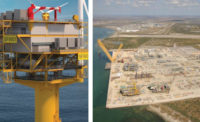
A July 21 ruling by the Federal Energy Regulatory Commission that reforms electric-transmission planning and allocation requirements is expected to support new solar- and wind-power development, according to two construction industry sources.
“FERC Order 1000 is a huge development that will open up the transmission cost allocation process and spur development of transmission projects,” says Gerald Schulz, vice president of electrical engineering at transmission contractor Michels Corp., Brownsville, Wis.
One component of the order is a requirement for transmission providers to participate in regional transmission planning processes. Another requires that providers in neighboring transmission planning regions cooperate to find cost-effective solutions to mutual transmission needs.
The 650-page order builds on prior transmission reforms and corrects remaining deficiencies regarding transmission planning processes and cost allocation methods, according to a FERC statement on the ruling.
Schulz says the order could assist with transmission development in energy-constrained regions. The rule should help Michels in building transmission lines in remote wind-generating regions, such as North Dakota and Minnesota, to population centers on both coasts, he says.
As for cost allocation, the ruling spreads the cost to the end users of the transmission project, a tactic that reduces the cost per person, Schulz says. Those who don’t benefit from the transmission will not pay.
“This gives more protection for the consumer,” he says. Previously, transmission-line costs were spread equally throughout a geographic region.




Post a comment to this article
Report Abusive Comment